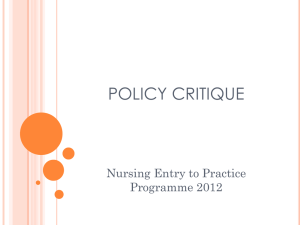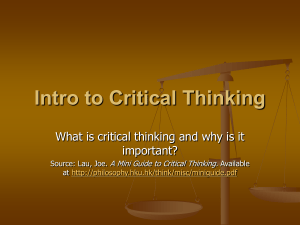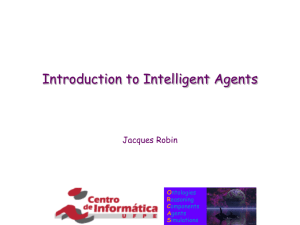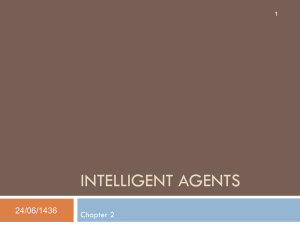Presentation - University of Maryland
advertisement
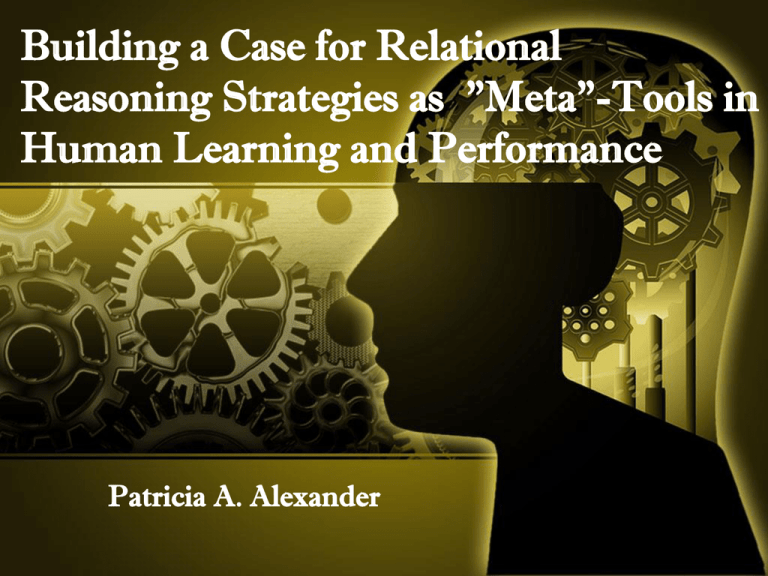
Building a Case for Relational Reasoning Strategies as "Meta"-Tools in Human Learning and Performance Patricia A. Alexander Goals • Forward a claim about the association between relational reasoning with metacognition theory and research • Consider the nature of percepts and concepts in human learning and performance • Explore a model of percept-concept coupling as linked to relational thinking and reasoning • Overview relational reasoning as metastrategic avenues for enhanced learning and performance RELATIONAL REASONING AND METACOGNITION BIT OF HISTORY… The train stopped in Centerville every day at both one o’clock and at five o’clock. Dr. Jones needed to travel from Centerville to Milltown on business. He decided to go by train. He packed his bags. He caught a train at seven o’clock, and was in Milltown in time for his meeting. Garner 1981 MY CONTENTION A failure to notice and to discern patterns within information contributes to metacognitive problems (e.g., error detection issues, calibration concerns, and lack of strategic or regulatory behavior) and, thus, negatively affects human learning and performance. Alexander, P. A. (1981). Predictive accuracy of third and fifth graders across linguistic and nonlinguistic comprehension measures: The relationship between performance on graduated passage questions under listening and reading conditions and the Standard Progressive Matrices. Unpublished doctoral dissertation. University of Maryland. RELATIONAL THINKING… …can be simply conceived as the ability to perceive associations between and among pieces of information; an automatic cognitive process that can occur with or without conscious awareness RELATIONAL REASONING… …is the intentional harnessing of relational thinking processes as a means of enhancing one’s understanding and performance LINKING PERCEPTS AND CONCEPTS TO METACOGNITIVE BEHAVIOR WHAT HAS CHANGED • Increased appreciation for noncognitive factors (e.g., interest) • Growing awareness of sociocontextual forces (e.g., task conditions or Internet) • Undeniable influence of in-themoment, dynamic aspects of learning and performance Undeniable influence of in-the-moment, dynamic aspects of learning and performance PERCEPT… …is a mental impression formed in the moment largely from sense data; what the mind “sees” at any given place and time. TOPOGRAPHY MATERIAL HUMAN PHYSICAL ENVIRONMENT AFFORDANCES CONSTRAINTS PERCEPT INDIVIDUAL DIFFERENCES FACTORS INDIVIDUAL CHARACTERISTICS STRATEGIC AND METASTRATEGIC ABILITIES PSYCHOSOCIAL FACTORS CONCEPTUAL UNDERSTANDING KNOWLEDGE GOALS/ INTENTIONS CONCEPT… …is a generalized understanding or notion derived over time and across multiple experiences in and with the world. The starting point of all our reasoning is…our percepts….It is the external world we directly observe. What passes within we only know as it is mirrored in external objects. Charles S. Peirce (1955) Two notes: On motives, on percepts. I see an inkstand on the table: that is a percept. Moving my head, I get a different percept of the inkstand. It coalesces with the other. What I call the inkstand is a generalized percept, a quasi-inference from percepts, perhaps I might say a compositephotograph of percepts….Of course, in being real and external, [the inkstand] does not in the least cease to be a purely psychical product, a generalized percept, like everything of which I can take any sort of cognizance. Charles S. Peirce (1955) Two notes: On motives, on percepts. Points of Comparison • Presentation • Re-Presentation • In mundi • In mente • Immediate • Over time • Impressionistic; • Can be examined or Largely felt or sensed justified • Continually in flux • Open to change • Reliant on individual • Reliant on individual differences differences • Requires relational thinking • Requires relational thinking and reasoning MODELING THE PERCEPTCONCEPT COUPLING We thus see clearly what is gained and what is lost when percepts are translated into concepts. Perception is solely of the here and now: conception is of the like and unlike, of the future, of the past, and of the far away. But this map of what surrounds the present, like all maps, is only a surface: its features are but abstract signs and symbols of things that in themselves are concrete bits of sensible experience. We have but to weigh extent against content, thickness against spread, and we see that for some purposes the one, for other purposes the other, has the higher value. Who can decide off-hand which is absolutely better to live or to understand life? We must do both alternately, and a man can no more limit himself either than a pair of scissors can cut with a single one of its blades. William James (1911/1996) Some problems of philosophy: A beginning of an introduction to philosophy, p. 74 IN FORMATION C1 PERCEPT P1 P2 P3 P4 C2 C3 CN CONCEPT Pn RT RT RR In the Moment In the Mind Presentation Re-Presentation Involuntary Cognitive Processing Involuntary and Voluntary Cognitive Processing R E F O R M A T I O N OFFERING RELATIONAL REASONING AS AVENUE FOR ENHANCED LEARNING AND PERFORMANCE LET’S PLAY A LITTLE CONCEPTUAL GAME! Write the first word that comes into your head… HOT BLACK UP FAST STUDENT-DIRECTED _____________ _____________ _____________ _____________ _____________ • Provide learners with means for harnessing attentional and perceptual processes • Can work individually or in concert to counter tendencies to piecemeal information or internalize fragmented knowledge • Foundational to learning and performance • Offers another venue for metastrategic development INTRODUCING THE FOUR As OF RELATIONAL REASONING CONFLICTS DISSIMILARITIES SIMILARITIES Involves the recognition of relational similarity between two seemingly disparate ideas, objects, or events ANOMALY Any occurrence or object that is strange, unusual, or unique; a discrepancy or deviation from an established pattern, rule, or trend ANTINOMY Refers to the mutual incompatibility, real or apparent, of two laws, rules, or principles Meritocracy Totalitarianism Aristocracy Monarchy Democracy Communism Dictatorship Fascism Anarchy Federalism Theocracy Arises when two propositions, principles, or explanations are set in direct contrast or direct opposition • Analogical reasoning has long been regarded as a mechanism for deeper conceptual understanding, conceptual change, and transfer (Clement, in press; Fugelsang & Dunbar, 2009; Thagard, in press) • Metacognitive awareness is also predicated on the ability to recognize how the information deviates in some nontrivial way from the prior patterns (anomalous reasoning: Chinn & Brewer, 1993; Chinn & Malhotra, 2002) • Recognizing the incompatibility of two ideas is basic to the formation of defensible scientific categories (antinomous reasoning: Carey, 1985; Chi, in press; Chi & Hausmann, 2003) • The ability to juxtapose arguments or counterarguments or deeply process refutation texts have been tied to learning and performance (antithetical reasoning: Murphy, 2009; Murphy & Alexander, in press; Sinatra & Mason, in press) CONCLUDING THOUGHTS • There is a continual orchestration between percept and concept in human thinking and reasoning and their oversight • Being attentive and perceptive would seem to be necessary but not sufficient conditions to being metacognitive • We continue to search for mechanisms for prompting and promoting metacognitive awareness and meta-strategic behavior in learners • Bringing relational reasoning to the forefront may contribute to learners’ awareness and strategic response • Measuring relational reasoning ability may afford insights into critical thinking dispositions or individual differences that matter to human learning and performance • There is much to be understood about relational reasoning and its role within human cognition and metacognition ACKNOWLEDGMENTS Peter Baggetta and Disciplined Reading and Disciplined Learning Research Laboratory Denis Dumas Lily Fountain Emily Fox Emily M. Grossnickle Courtney Hattan Alexandra List Sandra M. Loughlin Liliana Maggioni Taslima Rahman


